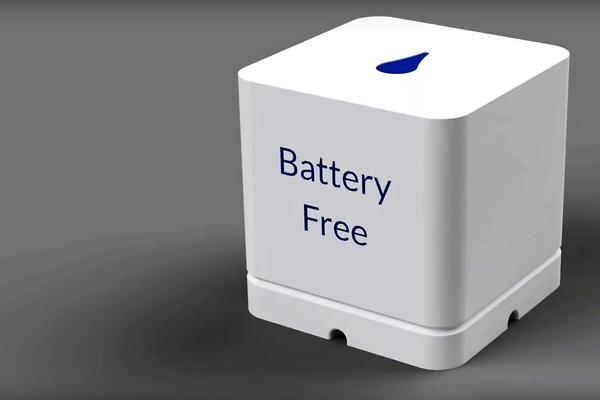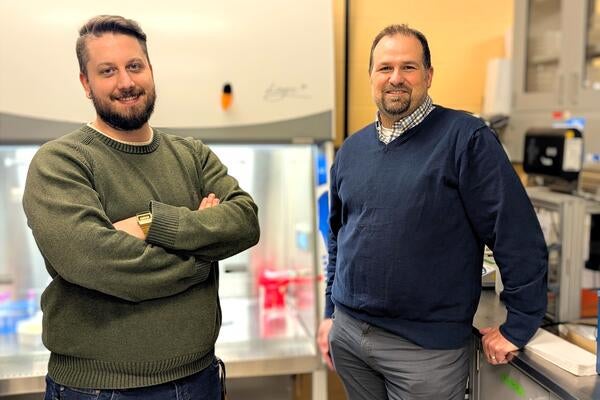
Protecting buildings from costly water damage
Battery-free sensor developed by Waterloo Engineering researchers uses nanotechnology to power itself while detecting leaks

Battery-free sensor developed by Waterloo Engineering researchers uses nanotechnology to power itself while detecting leaks
By Brian Caldwell Faculty of EngineeringA wireless, battery-free sensor invented by researchers at Waterloo Engineering can detect water leaks in buildings at a fraction of the cost of existing systems.
The tiny device, which is housed in a box just three centimetres square, uses nanotechnology to power itself and send an alert to smartphones when exposed to moisture.
By eliminating a battery and related circuitry, researchers estimate their sensor could be commercially produced for less than $1 each, much less than the cost of current leak detection devices on the market.
“One of the big issues related to water damage in buildings is that owners don’t install enough sensors because they are too expensive,” says George Shaker, a cross-appointed professor of electrical and computer engineering, and mechanical and mechatronics engineering. “The much lower cost of our sensor enables the deployment of many, many more to greatly improve protection.”

The leak detection sensor is housed in a box just three centimetres square.
Water leaks are the leading cause of property losses in apartments, offices and other buildings, resulting in expensive repairs and higher insurance premiums.
“By the time most leaks are detected now, they have done a lot of damage and are very costly to fix,” Shaker says. “It’s a huge problem.”
The new sensor, which is smaller than a nickel at five millimetres in diameter, is comprised of stacked nanoparticles. When the nanoparticles get wet, a chemical reaction produces enough electricity to power a wireless radio and additional sensors to record environmental conditions such as temperature.
The wireless radio and other sensors are on a circuit board packaged with the leak sensor in the three-centimeter-square box.
“We harvest the energy that is created when the sensor is exposed to water and that energy then powers the electronics to send an alert to the user’s cellphone via the internet,” says collaborator Norman Zhou, a professor of mechanical and mechatronics engineering, and a member of the Waterloo Institute for Nanotechnology.
In addition to being cheaper, the new sensor is environmentally friendly, resets after use, can be installed in hard-to-reach places - including otherwise inaccessible areas during building construction - and requires much less maintenance.
Researchers have filed four patent applications and are exploring commercialization of their sensor.
They are also pursuing other applications for the underlying technology, including use in diapers for the elderly and in bandages to detect wound leakage after surgery.
“We believe this has the potential to solve several important problems,” says Shaker.
A paper on the research, Development of novel water leak detection mesh network utilizing batteryless sensing nodes, was presented at SmartNets 2019: The 2019 International Conference on Smart Applications, Communications and Networking in Egypt.
The research team also included student Oliver Witham, postdoctoral fellow Ming Xiao, research associate Jiayun Feng, physics and astronomy professor Walter Duley, and graduate student Nathan Johnston.

Read more
Here are the people and events behind some of this year’s most compelling Waterloo stories

Engineering master's student Nayeema Nonta (left), one of the three paper authors, and her supervisor, Dr. Sirisha Rambhatla, in a large server room with the computer power needed to develop their new LLM training technique. (University of Waterloo)
Read more
Waterloo researchers develop highly efficient AI training system that paves the way for cheaper, greener “intelligent partners”

Read more
Engineering researchers team up to tackle the plastics pollution problem with microbial innovation and engineering design
Read
Engineering stories
Visit
Waterloo Engineering home
Contact
Waterloo Engineering
The University of Waterloo acknowledges that much of our work takes place on the traditional territory of the Neutral, Anishinaabeg, and Haudenosaunee peoples. Our main campus is situated on the Haldimand Tract, the land granted to the Six Nations that includes six miles on each side of the Grand River. Our active work toward reconciliation takes place across our campuses through research, learning, teaching, and community building, and is co-ordinated within the Office of Indigenous Relations.